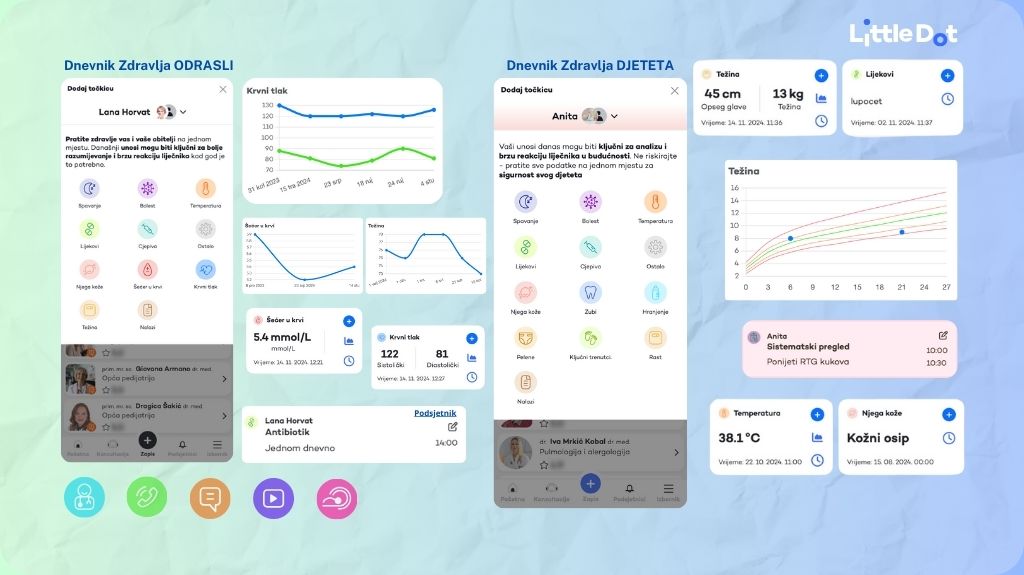At Littledot, we are committed to building a long-term relationship of trust and well-being with families by raising awareness about the environmental factors that affect children’s health.
How chemical toxins impact early childhood development
With the rapid expansion of industrial technologies, globalization, and global trade, human exposure to chemical substances has increased significantly in recent decades. This includes not only adults but also the most vulnerable among us—infants and young children.
Some studies estimate that chemical exposures may contribute to up to 85% of modern health conditions, although precise measurements are still challenging. The complexity arises from the vast number and diversity of chemical compounds, the cumulative duration of exposure, and varying sensitivity depending on the age and developmental stage of the individual.
The period from conception to the first year of life is considered the most sensitive window of development. During this time, exposure to even low levels of certain toxins—such as endocrine disruptors, heavy metals, and environmental pollutants—can cause long-term or even permanent effects on a child’s nervous, immune, and hormonal systems.
Understanding and minimizing this exposure is crucial for supporting healthy growth, cognitive development, and disease prevention later in life.
Chemicals that disrupt the endocrine system
Endocrine disruptors are chemical compounds that can imitate hormonal influences or influence the hormonal function. They most commonly imitate estrogen and are found in numerous products intended for commercial use, such as plastic bottles and containers, cans, detergents, fire retardants, toys, cosmetics and pesticides. These compounds possess the potential to alter hormonal balance, which is necessary for normal growth and development.
Bisphenol A
Bisphenol A is a widely used compound found in plastic and epoxy resin products. It is commonly used to slow the burning of plastics. BPA is often present in baby feeding bottles, beverage containers, and PVC water pipes, which has raised concern among health experts.
As plastic waste increases, BPA is continuously released from plastics into the environment. Its levels in underground and surface waters are rising. Laboratory studies have shown that BPA has clear effects on reproductive organs and the central nervous system. It is also linked to premature puberty, hormonal imbalance, and behavior changes such as increased aggression.
BPA may affect testosterone levels, breast tissue development, and sperm production. Clinical research has also associated BPA exposure with neurodevelopmental disorders, various chronic diseases, and problems affecting the liver, thyroid, heart, and pancreas.
Insecticides
Insecticides contain chemical compounds that can disrupt the endocrine system. Although banned for over 30 years, these substances are still found in the environment and in human tissues. One well-known example is DDT.
A study by the Centre for Women and Children’s Health at the Public Health Institute in Berkeley, California, revealed that girls exposed to DDT during the first 14 years of life were five times more likely to develop breast cancer later in life, compared to girls who were not exposed at that age.
Phthalates
Phthalates are chemical compounds which are added to plastic to provide for its firmness and elasticity. Unfortunately, they are continuously released from the plastic (they evaporate or are washed out) and since they are harmful to children, they have been banned from the production of children’s toys and bottles. Some endocrine disruptors have a potentially androgynous effect on the development of male reproductive organs. Phthalates are present in numerous widely used products, such as cosmetics (nail polish, hair colour and spray, deodorants, shampoos). Prenatal exposure to phthalates can cause a significant reduction in male behaviour patterns among boys. Some studies suggest that lavender and tea-plant oil also have an androgynous and anti-estrogen effect, so their regular use (massage, cosmetics) can cause gynecomastia at the preadolescent age. However, phthalates do not seem to have an immediate carcinogenic effect.
Perfluorooctanoic acid
Perfluorooctanoic acid (PFOA) is a chemical compound used in the production of Teflon (polytetrafluoroethylene). Results of laboratory experiments indicate that it significantly disrupts the development of glandular breast tissue and lactation. In animals, it was classified as toxic and carcinogenic. As a contaminant, this compound is found in water, food, dirt-resistant carpets, carpet cleaning products, clothes, Teflon dishes, and in areas around factories that produce chemicals and industrial waste. It is typically added to plastic bags used in thermic food processing (e.g. bags used for microwave popcorn). Research from the US claims that overall exposure to this compound is 98%.
Fire retardants
These include a group of chemical compounds added to textiles, car seats and polyurethane pillows aimed at reducing the spread of flames in the event of fire. Such compounds are released and may be inhaled or enter the organism through the skin. Laboratory animal tests indicate that these compounds may cause tumours and hormonal changes, which subsequently lead to reproductive and neurological development impairments.
Toxic chemical compounds in widely used products
Hidden toxins in cosmetics, clothing and cleaning products
Cosmetics, clothes, footwear, solvents, colours, and cleaning products contain tens of thousands of chemical compounds. Many of these are potentially harmful or confirmed to be dangerous to human health.
To give perspective, the cosmetic industry uses over 75,000 different chemicals, while textile manufacturing includes more than 8,000. Data on chemicals used in footwear is not widely available.
Nanoparticle technology is increasingly used in everyday items such as deodorants and wrinkle-resistant textiles. Due to their tiny size, these particles can easily enter the body. However, their long-term impact on health remains unclear.
When it comes to infant skin, the risks are even greater. Infant skin is nearly twice as permeable as adult skin. Additionally, the skin surface area relative to body weight is about seven times higher in infants compared to adults.
This means that babies can absorb more toxins through the skin. Phthalates, a group of chemicals used to soften plastics, are often found in parts of children’s clothing and footwear. These compounds are known endocrine disruptors and may pose developmental risks.
Textile processing frequently involves a wide range of toxic chemicals, including lead, cadmium, mercury, chromium, perfluorinated compounds, chlorobenzene, biocides, antifungals, azo dyes, chlorophenols, and short-chain chlorinated paraffins. These substances are concerning not only due to direct skin contact, but also because of their environmental impact—particularly through improper disposal of industrial and textile waste.
Surprisingly, certain everyday products, like infant socks, may be treated with antimicrobial agents designed to prevent the growth of bacteria and fungi.
Recent studies show that within just the first month of life, infants may be exposed to an average of 48 different chemical compounds through skincare and hygiene products. Unfortunately, national safety regulations still do not cover many of these substances.
For instance, the EU Cosmetics Directive (1223/2009) banned the use of 1,328 hazardous chemicals in cosmetics. However, it fails to address thousands of other compounds still commonly used in household and textile goods.
Food, water, and environmental pollutants
When it comes to food, water, and dietary supplements, several types of pollution should be considered. These include heavy metals, organic hydrocarbons, biocides, and biological contaminants such as bacteria, viruses, fungi, and their toxins. In addition, synthetic pollutants like preservatives and sweeteners may pose health concerns.
One compound of interest is HMF (hydroxymethylfurfural), which forms during the heating of corn starch in syrup production. This syrup is commonly used as a sweetener in soft drinks, herbal syrups, and sweets. HMF is produced through carbohydrate dehydration—a process that occurs during baking, drying, or cooking. This reaction improves both flavor and color, known as the Maillard reaction or caramelisation.
Although epidemiological studies do not show a clear harmful effect of HMF on human health, laboratory tests have found cytotoxic and genotoxic properties, raising concern.
Another widely discussed additive is aspartame (L-aspartyl-L-phenylalanine-methyl ester), used as a sweetener. Studies indicate that aspartame is non-toxic when consumed in moderate, regulated quantities. However, if racemisation occurs during production (transition from L-form to D-form), its safety could be compromised.
The health impact of Dioxins and Arsenic
Dioxins
Dioxins (polychlorinated dibenzodioxins) are highly stable, environmentally persistent chemical compounds. They are by-products of industrial processes such as PVC production, metal smelting, waste incineration, chlorine bleaching, and herbicide use. Natural events like volcanic eruptions and forest fires can also release dioxins into the environment.
The most common route of exposure for humans is through the consumption of contaminated meat, dairy, and fish. Tobacco smoke is another notable source. Dioxins accumulate in the body over time, and exposure has been linked to a wide range of health issues. Research shows they can affect the skin (causing chloracne), infant tooth enamel, the central and peripheral nervous system, thyroid gland, immune system, and may contribute to conditions such as endometriosis and diabetes.
Dioxins are classified as both carcinogenic and teratogenic.
Unfortunately, history has recorded multiple industrial accidents that led to severe dioxin contamination of the environment, affecting humans, animals, and plants. Infants are especially vulnerable, as dioxin exposure can begin in utero via the placenta and continue through breastfeeding.
According to the World Health Organization (WHO), there are clear guidelines regarding maximum daily, weekly, and yearly dioxin intake, based on their presence in specific food types.
Recent studies raise concerns about increasing rates of diabetes, obesity, asthma, and autism in children. These conditions are more frequently observed among children who have been breastfed for longer durations by mothers living in areas with elevated environmental dioxin levels.
One particularly troubling fact – the concentration of dioxin in breast milk may be up to 30 times higher than the level consumed directly by the mother.
Arsenic
Arsenic is a category-1 carcinogen (undoubtedly proven carcinogenicity). In addition to its acute toxic effects, it causes numerous health problems which may be visible for dozens of years after arsenic exposure (malignant diseases). This element passes through the placenta, causing a higher frequency of miscarriages, stillbirths and premature births. Early arsenic exposure is accompanied by a higher frequency of malignant tumours in adulthood. For the most part, arsenic enters underground waterways through the breakdown of alluvial layers (mineral rocks containing arsenic). Arsenic and its compounds are extremely mobile in the environment, not only due to their presence in underground waterways, but also their entry into organisms and in their spread through the food chain. Add to this the use of certain insecticides and pesticides that may also contain arsenic.
The presence of arsenic in drinking water represents a public health hazard in many countries. In eastern parts of Croatia, inorganic arsenic levels in underground waters considerably exceed the prescribed limits. It is to be hoped that the introduction of modern (considerably more expensive) methods of removing arsenic will decrease that level to within permitted boundaries. A considerable concentration of arsenic may also be found in rice. Since the majority of arsenic is found in the outer hull (husk), the safest thing is to eat dehusked rice. In contrast, integral, white rice and rice milk contain higher levels of this toxin.
Why infants and pregnant women are most vulnerable
Infants and pregnant women are particularly sensitive to environmental toxins. Special attention should be given to their potential exposure to chemicals from the following groups: insecticides, larvicides, herbicides, fungicides, bactericides, rodenticides, limacides, and nematocides. These substances are commonly used to eliminate unwanted plant and animal organisms in agriculture, food production, and household settings.
Many of these chemicals can enter the human body through food, water, aerosols, or skin and mucosal contact. Some are classified as highly toxic and harmful to both human health and the environment.
Since these substances are widely used in daily life, it is crucial to:
- Follow safety instructions
- Supervise their application more carefully
- Monitor food and water sources to avoid contamination
By adopting these preventive measures, we can significantly reduce the risks of chemical exposure during critical developmental periods.
Air pollution
Air in large cities is often heavily polluted with by-products from fossil fuels such as petrol, oil, and diesel. Infants and young children living in urban areas are particularly vulnerable, as they are more likely to suffer from respiratory illnesses, including allergies and infections.
Studies from New York have shown that children exposed to high levels of air pollution tend to score lower on IQ tests at the age of five. These children also show increased rates of anxiety, depression, and attention disorders compared to their peers in cleaner environments.
Many of these harmful effects are linked to chemicals like benzene (found in petrol) and particulate matter from diesel exhaust. These particles include microparticles (0.1 to 100 micrometres) and nanoparticles (1 to 100 nanometres), many of which are classified as carcinogens.
Due to their small size, these particles can pass through the lungs and enter the bloodstream, reaching various organs. While research is ongoing, their effects on cellular structures like membranes, organelles, and DNA remain poorly understood.
Despite limited safety data, nanoparticles are widely used in consumer products, including deodorants and wrinkle-resistant fabrics. Their widespread presence raises growing concerns, especially for infants and small children, whose developing bodies are more sensitive to environmental pollutants.
How to protect children and pregnant women from toxic substances
The human body is part of an ecosystem—deeply connected and inseparable from it. While people influence their environment, the environment also impacts every aspect of their lives, from genetics and biology to emotions and social well-being.
During pregnancy and early infancy, it is crucial to minimize exposure to potentially harmful chemicals. These early stages are particularly sensitive to toxic influences.
Given the vast number of harmful elements we encounter daily, it is essential to establish clear safety standards and national guidelines. These measures help protect vulnerable groups—especially pregnant women and children—and empower parents to make safer choices in their everyday lives.
Global best practices show that effective protection comes from coordinated efforts led by public health institutions and expert bodies. Collaboration among professionals in medicine, toxicology, food safety, textile and footwear technology, and ecology is key. Special attention must also be paid to safe and responsible waste disposal, as it plays a critical role in reducing long-term environmental exposure.
For any additional questions or concerns regarding your child’s health, infant growth and development, you can contact prof. dr. sc. Milivoja Jovančevića
Download LittleDot – Your Family’s Health Companion!
Easily manage your family’s health with our all-in-one app. Track medical records, consult with doctors, and stay ahead of every health need. Convenient, reliable, and always within reach. Download now and try it for free!







